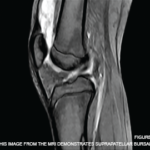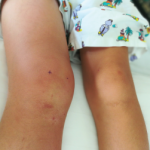Machine learning is a tool that may help pediatric rheumatologists distinguish between different subtypes of juvenile idiopathic arthritis (JIA) and predict treatment response.


The Children’s Hospital at Montefiore Pediatric Rheumatology Fellowship Program: Alisha Akinsete, MD; Malki Peskin, MD; & Jessica Perfetto, MD |
Machine learning is a tool that may help pediatric rheumatologists distinguish between different subtypes of juvenile idiopathic arthritis (JIA) and predict treatment response.

SAN DIEGO—In the pre-ACR Convergence 2023 Review Course, Rebecca Sadun, MD, PhD, assistant professor in medicine and pediatrics, Duke University School of Medicine, Durham, N.C., focused on transitions from pediatric to adult rheumatology care for patients with juvenile idiopathic arthritis (JIA).
Similar patterns of inflammation occur in the joints of patients with inflammatory arthritis, but in each individual, arthritis affects only a subset of possible anatomic areas. Chang et al. set out to identify patient-specific anatomic patterns of joint flare to distinguish local from systemic drivers of chronic disease.

Eman Bamashmous, MBBS, Buthaina Al Adba, MBBS, CABP, & Sharon Bout-Tabaku, MD, MSCE |
Intra-articular venous malformations of the knee are an uncommon cause of knee pain in children. Presenting symptoms of this rare subtype of venous malformation often include nonspecific pain and joint swelling, which may be episodic, and accompanied by limited range of motion. The signs and symptoms can mimic juvenile idiopathic arthritis (JIA). Timely diagnosis of…

ATLANTA—Managing pediatric patients with rheumatic disease involves special considerations, such as developmental concerns and physiological traits that may affect dosing of medications, according to two experts. During a session at the 2019 ACR/ARP Annual Meeting, Courtney Kremer, ARNP, a pediatric nurse practitioner at the University of Iowa Stead Family Children’s Hospital, Iowa City, and Jessica…

In Canada, five provinces will now reimburse patients with plaque psoriasis who use risankizumab. Also, Canada Health has approved apremilast for treating adults with plaque psoriasis and psoriatic arthritis…

CHICAGO—When it comes to correctly diagnosing joint pain in children, “things take time,” said Michael L. Miller, MD, quoting Danish physicist and poet Piet Hein. Children with pain but normal physical examinations may need to return to the clinic for repeat evaluation over several months. “I often tell parents that laboratory tests may help in…

The evaluation of a child with arthralgia who has a normal physical examination provides a challenge to rheumatologists. Here are some insights into assessing and treating children with musculoskeletal pain syndromes…

Inflammatory diseases can cause uveitis. Early detection and treatment are essential, but when uveitis goes undetected it can cause blindness. Here’s how to protect your patients…

Lisa G. Rider, MD, & Frederick W. Miller, MD, PhD |
Systemic autoimmune diseases are thought to result from immune dysregulation in genetically susceptible individuals who were exposed to environmental risk factors. Many studies have identified genetic risk factors for these diseases, but concordance rates among monozygotic twins are 25–40%, suggesting that nonheritable environmental factors play a more prominent role.1,2 Through carefully conducted epidemiologic and other…